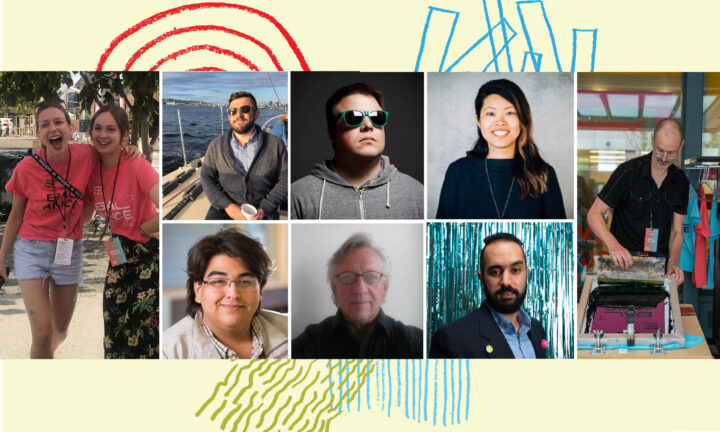We are celebrating the tenth year of the Seattle Design Festival, and for ten years the Festival Planning Committee, a group of volunteers, has worked to build a platform intended to both celebrate design and empower design professionals to work towards creating more equitable, resilient, and thriving communities. 2020 in particular seems to ache for a platform like this— for an opportunity to explore and examine the role of design in shaping our world and the systems that guide it.
In the wake of COVID-19 and the racial justice uprisings we’ve seen this year, the committee has reflected on the role the Festival plays in this work, the shortcomings we are guilty of, and the work that is left to be done. The Festival Planning Committee is working hard behind the scenes with partners to deliver programming that is inclusive, relevant, and inspiring.
We would like to introduce you to this amazing group of volunteers who shape the Festival each year, and who help hold us accountable to our goals, mission, and vision for the Seattle Design Festival. Pictured above are our core 2020 Committee members (clockwise, starting upper left) Elana Darnell, Julia Edwards, Adam Ury, Trevor Dykstra, Lisa Sato, Matt McWilliams, Yasir Altemeemi, George Zatloka, and Uris Giron (not pictured Michelle Gagnon-Creeley).
First we introduce Matt McWilliams, who serves as the Chair of the Community Spotlights Team:
I am not a designer by education or trade. I am not an architect. I am not an urban planner. Nor do I work in some other traditional design discipline.
Still I have volunteered for the Seattle Design Festival for the last three years because I like to think about the role of design in helping people envision a different, better and more inclusive future. I also believe that good design enables people to better see, explore, understand and value different viewpoints to shared problems.
My personal design journey has been complicated. It has taken me from Atlanta to Seattle. It meanders through issues related to fair elections, free markets, housing choice, mobility options and the purpose of the places I have shared with others, whether that has involved co-workers or neighbors.
Current circumstances have amplified those tensions.
I moved to Seattle seven years ago to continue my education. But I also needed to change my perspective. I welcomed studying matters of culture and communication that exhibits such a strong association to place.
After all, for most of my professional life, I had worked in public policy in Georgia and advocated for consumer financial protections and increased access to affordable health care. I had even helped with election reform following the infamous Florida recount. Georgia had similar issues, failing to count 94,000 votes in that same election.
State officials embraced electronic voting, implementing the changes in time for the 2002 elections. The new equipment proved easy to use.
But it also enabled cynical political forces. The altered stakes led to legislation restricting voter eligibility, additional legal challenges and other questions regarding the means and meanings of the franchise.
And this largely reflects cultural changes animated by forces of globalization and technology. Awareness of the world has grown. Emerging tools offer novel ways to navigate information and tell stories. But it has become increasingly difficult to trust those stories, as they seem to have become less bound by a shared sense of place.
It suggests the human tendency towards personal bias as one means for processing conflicting information. It skews the perception of risk, reward and the actual contributions of others in common enterprises.
A counter-argument has now found expression in unexpected ways. It has repurposed spaces. It has lent voice to protest. It has driven brands to reconsider their advertising practices.
I often reflect upon my earlier design interactions when I still lived in Atlanta. One of its pressing problems included sidewalk infrastructure maintained by private interests. Since their upkeep solely depends on the adjacent property owners, sidewalks have fallen into a desperate state of disrepair and inconsistent standards. It not only reflects the city’s early origins as a corporate enterprise but the recent legacy of white flight.
The effect on the city remains profound, and it can make it difficult to experience a richness of place where it’s also possible to enjoy community. My neighbor Mrs. Sims had once remarked upon this delicate concept when she shared her concern that other neighbors may not think kindly about our odd fellowship.
As we stood on the sidewalk, I could not help but think that no one in the neighborhood actually cared.
Then the financial crisis happened. It imposed a terrible toll on my neighborhood. Many lost their homes. Families lost the ability to pass wealth to their children. The only meaningful choice was survival.
Nowadays I realize that Mrs. Sims’ concerns had merit. She carried the trauma of her personal story. She possessed a unique insight into a cultural inattention to design practices and intent. She knew that it made all of us vulnerable.
Sometimes it’s worth talking about difficult matters of design, and it heartens me to see that so many others think so too. I look forward to those conversations, no matter where we might have them.
I enjoy the perspective.





